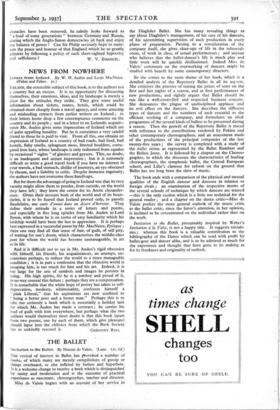THE BALLET
Invitation to the Ballet. By Ninette de Valois. (Lane. 12s. 6d.)
THE revival of interest in Ballet has provoked a number of books, of which many are merely compilations of gossip or things overheard, or else inflated by bathos and hyperbole. It is a welcome change to receive a book which is distinguished by sanity and moderation and is the outcome of practical experience as executant, choreographer, teacher and director.
Miss de Valois begins with an account of her service in
the Diaghilev Ballet. She has many revealing things to say about Diaghilev's management, of his care of his dancers, of his unremitting supervision of each production in every phase of preparation. Passing to a consideration of the company itself, she gives close-ups of life in the rehearsal- room, of work in class, of actual performances ; and anyone who believes that the ballet-dancer's life is much play and little work will be quickly disillusioned. Indeed Miss de t Valois' comments on the overworking of dancers might be studied with benefit by some contemporary directors.
So she comes to the main theme of her book, which is a detailed analysis of the Repertory Ballet in all its asp txts. She criticises the practice of raising the prices of seats on the first and last nights of a season, and at first performances of new productions, and rightly argues that Ballet should be run like a well-controlled and respected business concern. She denounces the plague of undisciplined applause and its evil effect on the dancers. She describes the different types of dancers and the numbers of each essential to the efficient working of a company, and formulates an ideal programme of the several kinds of ballets to be presented during a season. Then the growth of the Repertory Ballet is traced with reference to the contributions rendered by Fokine and other contemporary choreographers, and an assessment made of the productions of the principal companies of the last twenty-five years ; the survey is completed with a study of the ballet infirm as represented by the Ballet Rambert and the Ballets Jooss. It is followed by a chapter on the Chore°. grapher, in which she discusses the characteristics of leading choreographers, the symphonic ballet, the Central European school, and Lifar's clamour for reform on the ground that Ballet has too long been the slave of music.
The book ends with a comparison of the physical and mental qualities of the English danseur and danseuse in relation to foreign rivals ; an examination of the respective merits of the several schools of technique by which dancers are trained —this is the only section which is a little too technical for the general reader ; and a chapter on the dance critic—Miss de Valois prefers the more general outlook of the music critic to the ballet critic, since the latter's attention, in her opinion, is inclined to be concentrated on the individual rather than on the work.
Invitation to the Ballet, presumably inspired by Weber's Invitation a la Valse, is not a happy title. It suggests triviali- ties ; whereas this book is a valuable contribution to the bibliography of the Dance which can be read with profit by ballet-goer and dancer alike, and is to be admired as much for the experience and thought that have gone to its making as for its frankness and originality of outlook.










































 Previous page
Previous page